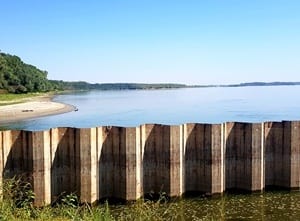EFFICIENT USE OF STEEL SHEET PILES IN BUILDING OR STRENGTHENING PROTECTION OF DAMS OR AGAINST FLOOD
Floods are hydrological hazards that cause great damage to both material level and to human lives. Their production is due to the penetration into river beds of large amounts of water that can cause landslides, shore-shaking and old dams rupture.
Dewatering and Silent Piling is concerned about these hydrological hazards, providing effective solutions for building flood protection structures using synthetic and steel sheet piles, while balancing costs and execution speed.
Ⓐ Metal sheet piles can be used in a wide range of flood protection or shore protection systems.
Ⓑ In the construction of new dams, metal sheet piles can ensure their tightness, stability and support.
Ⓒ In the case of existing dams, metal sheet piles can be used to strengthen them.
Ⓓ When space is not sufficient for the construction of a conventional dam, such as port or urban areas, metal sheet piles may themselves form a protective wall against the banks or against floods.
Ⓔ Often in the construction of dams with the role of flood protection, metal sheet piles are used as sealing thresholds. The tightness of metal sheet piles can be obtained by naturally depositing the soil in their interlocks. For a complete sealing of the interlocks, different solutions for sealing the interlocks can also be used. A wall of metal sheet piles with the role of threshold, not only reduces or prevents infiltrations inside the dam, but also improves its stability.
Ⓕ A wall made of metal sheet piles cannot be dug by wild animals or penetrated by tree roots. Due to this, the risk of reverse erosion is eliminated.
Ⓖ The use of metal sheet piles in the construction of the dam also gives us the possibility to modify it to cope with a larger amount of water, without the need to occupy a larger space. This is done by designing the wall of the metal sheet piles according to the required height from the canopy of the dam. Thus, a smaller footprint of the dam is obtained compared to the footprint that would have resulted for the same height without the use of sheet piles.
Ⓗ Due to the bending strength of the metal sheet piles, the walls built in the console have no difficulty in transferring the high water pressure to the bottom of the dam.
Ⓘ The walls of metal sheet piles built at the foot of the dam play an important role in stabilizing the slope and redirecting the earth pressure from the shoulder of the dam to the foundation.
Ⓙ In fact, metal sheet piles can be used to protect buildings from landslides.
READ MORE:
✔ The Role of Steel Sheet Piles in the Construction of Protection Systems of Dams and against Floods (RO Content)


























